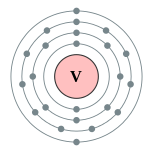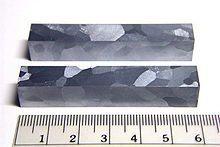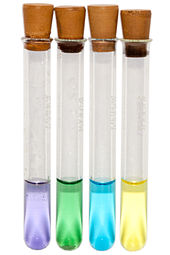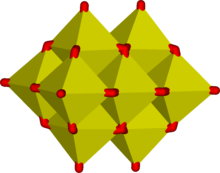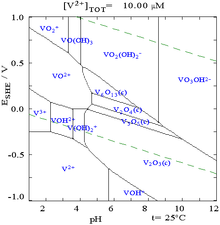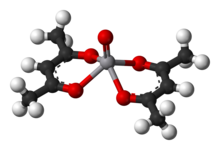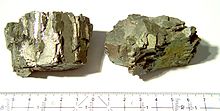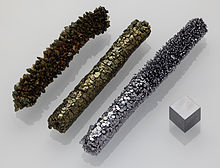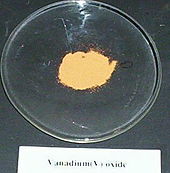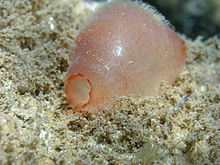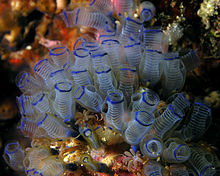
Vanadium
Background Information
Arranging a Wikipedia selection for schools in the developing world without internet was an initiative by SOS Children. Click here for more information on SOS Children.
| Vanadium | ||||||||||||||||||||||||||||||||||
|---|---|---|---|---|---|---|---|---|---|---|---|---|---|---|---|---|---|---|---|---|---|---|---|---|---|---|---|---|---|---|---|---|---|---|
|
23V
|
||||||||||||||||||||||||||||||||||
|
||||||||||||||||||||||||||||||||||
| Appearance | ||||||||||||||||||||||||||||||||||
blue-silver-grey metal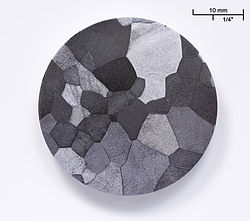 |
||||||||||||||||||||||||||||||||||
| General properties | ||||||||||||||||||||||||||||||||||
| Name, symbol, number | vanadium, V, 23 | |||||||||||||||||||||||||||||||||
| Pronunciation | / v ə ˈ n eɪ d i ə m / və-NAY-dee-əm |
|||||||||||||||||||||||||||||||||
| Metallic category | transition metal | |||||||||||||||||||||||||||||||||
| Group, period, block | 5, 4, d | |||||||||||||||||||||||||||||||||
| Standard atomic weight | 50.9415(1) | |||||||||||||||||||||||||||||||||
| Electron configuration | [Ar] 3d3 4s2 2, 8, 11, 2 |
|||||||||||||||||||||||||||||||||
| History | ||||||||||||||||||||||||||||||||||
| Discovery | Andrés Manuel del Río (1801) | |||||||||||||||||||||||||||||||||
| First isolation | Nils Gabriel Sefström (1830) | |||||||||||||||||||||||||||||||||
| Named by | Nils Gabriel Sefström (1830) | |||||||||||||||||||||||||||||||||
| Physical properties | ||||||||||||||||||||||||||||||||||
| Phase | solid | |||||||||||||||||||||||||||||||||
| Density (near r.t.) | 6.0 g·cm−3 | |||||||||||||||||||||||||||||||||
| Liquid density at m.p. | 5.5 g·cm−3 | |||||||||||||||||||||||||||||||||
| Melting point | 2183 K, 1910 °C, 3470 °F | |||||||||||||||||||||||||||||||||
| Boiling point | 3680 K, 3407 °C, 6165 °F | |||||||||||||||||||||||||||||||||
| Heat of fusion | 21.5 kJ·mol−1 | |||||||||||||||||||||||||||||||||
| Heat of vaporization | 459 kJ·mol−1 | |||||||||||||||||||||||||||||||||
| Molar heat capacity | 24.89 J·mol−1·K−1 | |||||||||||||||||||||||||||||||||
| Vapor pressure | ||||||||||||||||||||||||||||||||||
|
||||||||||||||||||||||||||||||||||
| Atomic properties | ||||||||||||||||||||||||||||||||||
| Oxidation states | 5, 4, 3, 2, 1, -1 ( amphoteric oxide) |
|||||||||||||||||||||||||||||||||
| Electronegativity | 1.63 (Pauling scale) | |||||||||||||||||||||||||||||||||
| Ionization energies ( more) |
1st: 650.9 kJ·mol−1 | |||||||||||||||||||||||||||||||||
| 2nd: 1414 kJ·mol−1 | ||||||||||||||||||||||||||||||||||
| 3rd: 2830 kJ·mol−1 | ||||||||||||||||||||||||||||||||||
| Atomic radius | 134 pm | |||||||||||||||||||||||||||||||||
| Covalent radius | 153±8 pm | |||||||||||||||||||||||||||||||||
| Miscellanea | ||||||||||||||||||||||||||||||||||
| Crystal structure | body-centered cubic | |||||||||||||||||||||||||||||||||
| Magnetic ordering | paramagnetic | |||||||||||||||||||||||||||||||||
| Electrical resistivity | (20 °C) 197 nΩ·m | |||||||||||||||||||||||||||||||||
| Thermal conductivity | 30.7 W·m−1·K−1 | |||||||||||||||||||||||||||||||||
| Thermal expansion | (25 °C) 8.4 µm·m−1·K−1 | |||||||||||||||||||||||||||||||||
| Speed of sound (thin rod) | (20 °C) 4560 m·s−1 | |||||||||||||||||||||||||||||||||
| Young's modulus | 128 GPa | |||||||||||||||||||||||||||||||||
| Shear modulus | 47 GPa | |||||||||||||||||||||||||||||||||
| Bulk modulus | 160 GPa | |||||||||||||||||||||||||||||||||
| Poisson ratio | 0.37 | |||||||||||||||||||||||||||||||||
| Mohs hardness | 6.7 | |||||||||||||||||||||||||||||||||
| CAS registry number | 7440-62-2 | |||||||||||||||||||||||||||||||||
| Most stable isotopes | ||||||||||||||||||||||||||||||||||
| Main article: Isotopes of vanadium | ||||||||||||||||||||||||||||||||||
|
||||||||||||||||||||||||||||||||||
Vanadium is a chemical element with the symbol V and atomic number 23. It is a hard, silvery gray, ductile and malleable transition metal. The element is found only in chemically combined form in nature, but once isolated artificially, the formation of an oxide layer stabilizes the free metal somewhat against further oxidation. Andrés Manuel del Río discovered compounds of vanadium in 1801 by analyzing a new lead-bearing mineral he called "brown lead," and presumed its qualities were due to the presence of a new element, which he named erythronium (Greek for "red") since, upon heating, most of its salts turned from their initial colour to red. Four years later, however, he was convinced by other scientists that erythronium was identical to chromium. Chlorides of vanadium were generated in 1830 by Nils Gabriel Sefström who thereby proved that a new element was involved, which he named "vanadium" after the Germanic goddess of beauty and fertility, Vanadís ( Freyja). Both names were attributed to the wide range of colors found in vanadium compounds. Del Rio's lead mineral was later renamed vanadinite for its vanadium content. Although Berzelius claimed to have first isolated vanadium in the 1830s, in 1867 Henry Enfield Roscoe showed that he had only obtained the oxide, and finally in 1869 Roscoe demonstrated a method to obtain the pure element.
Vanadium occurs naturally in about 65 different minerals and in fossil fuel deposits. It is produced in China and Russia from steel smelter slag; other countries produce it either from the flue dust of heavy oil, or as a byproduct of uranium mining. It is mainly used to produce specialty steel alloys such as high speed tool steels. The most important industrial vanadium compound, vanadium pentoxide, is used as a catalyst for the production of sulfuric acid.
Large amounts of vanadium ions are found in a few organisms, possibly as a toxin. The oxide and some other salts of vanadium have moderate toxicity. Particularly in the ocean, vanadium is used by some life forms as an active centre of enzymes, such as the vanadium bromoperoxidase of some ocean algae. Vanadium is probably a micronutrient in mammals, including humans, but its precise role in this regard is unknown.
History
Vanadium was originally discovered by Andrés Manuel del Río, a Spanish-born Mexican mineralogist, in 1801. Del Río extracted the element from a sample of Mexican "brown lead" ore, later named vanadinite. He found that its salts exhibit a wide variety of colors, and as a result he named the element panchromium (Greek: παγχρώμιο "all colors"). Later, Del Río renamed the element erythronium (Greek: ερυθρός "red") as most of its salts turned red upon heating. In 1805, the French chemist Hippolyte Victor Collet-Descotils, backed by del Río's friend Baron Alexander von Humboldt, incorrectly declared that del Río's new element was only an impure sample of chromium. Del Río accepted Collet-Descotils' statement and retracted his claim.
In 1831, the Swedish chemist Nils Gabriel Sefström rediscovered the element in a new oxide he found while working with iron ores. Later that same year, Friedrich Wöhler confirmed del Río's earlier work. Sefström chose a name beginning with V, which had not been assigned to any element yet. He called the element vanadium after Old Norse Vanadís (another name for the Norse Vanr goddess Freyja, whose facets include connections to beauty and fertility), because of the many beautifully colored chemical compounds it produces. In 1831, the geologist George William Featherstonhaugh suggested that vanadium should be renamed "rionium" after del Río, but this suggestion was not followed.
The isolation of vanadium metal proved difficult. In 1831, Berzelius reported the production of the metal, but Henry Enfield Roscoe showed that Berzelius had in fact produced the nitride, vanadium nitride (VN). Roscoe eventually produced the metal in 1867 by reduction of vanadium(II) chloride, VCl2, with hydrogen. In 1927, pure vanadium was produced by reducing vanadium pentoxide with calcium. The first large-scale industrial use of vanadium in steels was found in the chassis of the Ford Model T, inspired by French race cars. Vanadium steel allowed for reduced weight while simultaneously increasing tensile strength.
Characteristics
Vanadium is a hard, ductile, silver-gray metal. Some sources describe vanadium as "soft", perhaps because it is ductile, malleable and not brittle. Vanadium is harder than most metals and steels (see Hardnesses of the elements (data page) and iron). It has good resistance to corrosion and it is stable against alkalis, sulfuric and hydrochloric acids. It is oxidized in air at about 933 K (660 °C, 1220 °F), although an oxide layer forms even at room temperature.
Isotopes
Naturally occurring vanadium is composed of one stable isotope 51V and one radioactive isotope 50V. The latter has a half-life of 1.5×1017 years and a natural abundance 0.25%. 51V has a nuclear spin of 7/2 which is useful for NMR spectroscopy. 24 artificial radioisotopes have been characterized, ranging in mass number from 40 to 65. The most stable of these isotopes are 49V with a half-life of 330 days, and 48V with a half-life of 16.0 days. All of the remaining radioactive isotopes have half-lives shorter than an hour, most of which are below 10 seconds. At least 4 isotopes have metastable excited states. Electron capture is the main decay mode for isotopes lighter than the 51V. For the heavier ones, the most common mode is beta decay. The electron capture reactions lead to the formation of element 22 (titanium) isotopes, while for beta decay, it leads to element 24 (chromium) isotopes.
Chemistry and compounds
The chemistry of vanadium is noteworthy for the accessibility of the four adjacent oxidation states 2-5. In aqueous solution the colours are lilac V2+(aq), green V3+(aq), blue VO2+(aq) and, at high pH, yellow VO42-. Vanadium(II) compounds are reducing agents, and vanadium(V) compounds are oxidizing agents. Vanadium(IV) compounds often exist as vanadyl derivatives which contain the VO2+ centre.
Ammonium vanadate(V) (NH4VO3) can be successively reduced with elemental zinc to obtain the different colors of vanadium in these four oxidation states. Lower oxidation states occur in compounds such as V(CO)6, [V(CO)6]− and substituted derivatives.
The vanadium redox battery utilizes all four oxidation states; one electrode uses the +5/+4 couple and the other uses the +3/+2 couple. Conversion of these oxidation states is illustrated by the reduction of a strongly acidic solution of a vanadium(V) compound with zinc dust or amalgam. The initial yellow colour characteristic of the pervanadyl ion [VO2(H2O)4]+ is replaced by the blue colour of [VO(H2O)5]2+, followed by the green colour of [V(H2O)6]3+ and then the violet colour due to [V(H2O)6]2+.
The most commercially important compound is vanadium pentoxide, which is used as a catalyst for the production of sulfuric acid. This compound oxidizes sulfur dioxide (SO2) to the trioxide (SO3). In this redox reaction, sulfur is oxidized from +4 to +6, and vanadium is reduced from +5 to +3:
- V2O5 + 2 SO2 → V2O3 + 2 SO3
The catalyst is regenerated by oxidation with air:
- V2O3 + O2 → V2O5
Oxy-anions and cations
The oxyanion chemistry of vanadium(V) is complex: the predominance diagram for vanadates in aqueous solution shows at least 11 species to be predominant under specified conditions of pH and concentration. The tetrahedral vanadate ion, VO3−
4, is the principal species present at pH 12-14. On acidification, the monomer [HVO4]2- and dimer [V2O7]- are formed, with the monomer predominant at vanadium concentration of less than ca. 10−2M (pV > 2; pV is equal to minus the logarithm of the total vanadium concentration/M). The formation of the divanadate ion is analogous to the formation of the dichromate ion. As the pH is reduced, further protonation and polymerization to polyvanadates occur: at pH 4-6 [H2VO4]- is predominant at pV greater than ca. 4, while at higher concentrations trimers and tetramers are formed. Between pH 2-4 decavanadates predominate. In decavanadates there is a distorted octahedron of oxygen atoms around each vanadium atom. Vanadic acid, H3VO4 has a very low concentration because protonation of the tetrahedral species [H2VO4]- results in the preferential formation of the octahedral [VO2(H2O)4]+ species. In strongly acidic solutions, pH<2. [VO2(H2O)4]+ is the predominant species, while the oxide V2O5 precipitates from solution at high concentrations. The oxide is formally the inorganic anhydride of vanadic acid. The structures of many of these and other vanadate ions have been determined by X-ray crystallography of crystalline compounds.
The acid dissociation constants for the vanadium and phosphorus series are remarkably similar. Chains, rings and clusters involving tetrahedral vanadium, analogous to the polyphosphates, are known. The correspondence between vanadate and phosphate chemistry can be attributed to the similarity in size and charge of phosphorus(V) and vanadium(V). Orthovanadate VO3−
4 is used in protein crystallography to study the biochemistry of phosphate.
The Pourbaix diagram for vanadium in water, which shows the redox potentials between various vanadium species in different oxidation states is also complex.
Vanadium(V) also forms various peroxo-complexes. The species VO(O)2(H2O)4+ is present in acidic solutions. In alkaline solutions species with 2, 3 and 4 peroxide groups are present; the last forms violet crystals M3V(O2)4 nH2O (M=Li, Na, K, NH4+), in which the vanadium has an 8-coordinate dodecahedral structure.
Chalcogenide and halide compounds
Vanadium forms a very large variety of binary compounds with sulfur, selenium and tellurium, often with complicated structures. The tetrahedral sulfa-anion [VS4]3-, analogous to the orthovanadate ion, is well-known, but there are no thio-analogues of the polymeric oxo-vanadates.
All four halides are known for oxidation states +2 and +3, but the iodide is not known for V(IV) and VF5 is the only halide known for oxidation state 5. VCl4 may be used as a catalyst for polymerization of dienes.
Examples of oxyhalides include.
- vanadium(V): VOF3, VOX3 and VO2X (X=F, Cl)
- vanadium(IV): VOX2 (X=F, Cl, Br)
- vanadium(III): VOX, (X=Cl,Br)
Coordination compounds
Vanadium's early position in the transition metal series lead to three rather unusual features of the coordination chemistry of vanadium. Firstly, metallic vanadium has the electronic configuration [Ar]3d34s2, so compounds of vanadium are relatively electron-poor. Consequently, most binary compounds are Lewis acids (electron pair acceptors); examples are all the halides forming octahedral adducts with the formula VXnL6−n (X = halide; L = other ligand). Secondly, the vanadium ion is rather large and can achieve coordination numbers higher than 6, as is the case in [V(CN)7]4−. Thirdly, the vanadyl ion, VO2+, is featured in many complexes of vanadium(IV) such as vanadyl acetylacetonate (V(=O)5(C5H7)2). In this complex, the vanadium is 5-coordinate, square pyramidal, meaning that a sixth ligand, such as pyridine, may be attached, though the association constant of this process is small. Many 5-coordinate vanadyl complexes have a trigonal bypyramidal geometry, such as VOCl2(NMe3)2.
Organometallic compounds
Organometallic chemistry of vanadium is well developed, but organometallic compounds are of minor commercial significance. Vanadocene dichloride is a versatile starting reagent and even finds minor applications in organic chemistry. Vanadium carbonyl, V(CO)6, is a rare example of a metal carbonyl containing an unpaired electron, but which exists without dimerization. The addition of an electron yields V(CO)−
6 ( isoelectronic with Cr(CO)6), which may be further reduced with sodium in liquid ammonia to yield V(CO)3−
6 (isoelectronic with Fe(CO)5).
Occurrence
Metallic vanadium is not found in nature, but is known to exist in about 65 different minerals. Economically significant examples include patronite (VS4), vanadinite (Pb5(VO4)3Cl), and carnotite (K2(UO2)2(VO4)2·3H2O). Much of the world's vanadium production is sourced from vanadium-bearing magnetite found in ultramafic gabbro bodies. Vanadium is mined mostly in South Africa, north-western China, and eastern Russia. In 2010 these three countries mined more than 98% of the 56,000 tonnes of produced vanadium.
Vanadium is also present in bauxite and in fossil fuel deposits such as crude oil, coal, oil shale and tar sands. In crude oil, concentrations up to 1200 ppm have been reported. When such oil products are burned, the traces of vanadium may initiate corrosion in motors and boilers. An estimated 110,000 tonnes of vanadium per year are released into the atmosphere by burning fossil fuels. Vanadium has also been detected spectroscopically in light from the Sun and some other stars.
Production
Most vanadium is used as an alloy called ferrovanadium as an additive to improve steels. Ferrovanadium is produced directly by reducing a mixture of vanadium oxide, iron oxides and iron in an electric furnace. Vanadium-bearing magnetite iron ore is the main source for the production of vanadium. The vanadium ends up in pig iron produced from vanadium bearing magnetite. During steel production, oxygen is blown into the pig iron, oxidizing the carbon and most of the other impurities, forming slag. Depending on the ore used, the slag contains up to 25% of vanadium.
Vanadium metal is obtained via a multistep process that begins with the roasting of crushed ore with NaCl or Na2CO3 at about 850 °C to give sodium metavanadate (NaVO3). An aqueous extract of this solid is acidified to give "red cake", a polyvanadate salt, which is reduced with calcium metal. As an alternative for small-scale production, vanadium pentoxide is reduced with hydrogen or magnesium. Many other methods are also in use, in all of which vanadium is produced as a byproduct of other processes. Purification of vanadium is possible by the crystal bar process developed by Anton Eduard van Arkel and Jan Hendrik de Boer in 1925. It involves the formation of the metal iodide, in this example vanadium(III) iodide, and the subsequent decomposition to yield pure metal.
- 2 V + 3 I2
 2 VI3
2 VI3
Applications
Alloys
Approximately 85% of vanadium produced is used as ferrovanadium or as a steel additive. The considerable increase of strength in steel containing small amounts of vanadium was discovered in the beginning of the 20th century. Vanadium forms stable nitrides and carbides, resulting in a significant increase in the strength of the steel. From that time on vanadium steel was used for applications in axles, bicycle frames, crankshafts, gears, and other critical components. There are two groups of vanadium containing steel alloy groups. Vanadium high-carbon steel alloys contain 0.15% to 0.25% vanadium and high speed tool steels (HSS) have a vanadium content of 1% to 5%. For high speed tool steels, a hardness above HRC 60 can be achieved. HSS steel is used in surgical instruments and tools.
Vanadium stabilizes the beta form of titanium and increases the strength and temperature stability of titanium. Mixed with aluminium in titanium alloys it is used in jet engines, high-speed airframes and dental implants. One of the common alloys is Titanium 6AL-4V, a titanium alloy with 6% aluminium and 4% vanadium.
Other uses
Vanadium is compatible with iron and titanium, therefore vanadium foil is used in cladding titanium to steel. The moderate thermal neutron-capture cross-section and the short half-life of the isotopes produced by neutron capture makes vanadium a suitable material for the inner structure of a fusion reactor. Several vanadium alloys show superconducting behaviour. The first A15 phase superconductor was a vanadium compound, V3Si, which was discovered in 1952. Vanadium-gallium tape is used in superconducting magnets (17.5 teslas or 175,000 gauss). The structure of the superconducting A15 phase of V3Ga is similar to that of the more common Nb3Sn and Nb3Ti.
The most common oxide of vanadium, vanadium pentoxide V2O5, is used as a catalyst in manufacturing sulfuric acid by the contact process and as an oxidizer in maleic anhydride production. Vanadium pentoxide is also used in making ceramics. Another oxide of vanadium, vanadium dioxide VO2, is used in the production of glass coatings, which blocks infrared radiation (and not visible light) at a specific temperature. Vanadium oxide can be used to induce colour centers in corundum to create simulated alexandrite jewelry, although alexandrite in nature is a chrysoberyl. The possibility to use vanadium redox couples in both half-cells, thereby eliminating the problem of cross contamination by diffusion of ions across the membrane is the advantage of vanadium redox rechargeable batteries. Vanadate can be used for protecting steel against rust and corrosion by electrochemical conversion coating. Lithium vanadium oxide has been proposed for use as a high energy density anode for lithium ion batteries, at 745 Wh/L when paired with a lithium cobalt oxide cathode. It has been proposed by some researchers that a small amount, 40 to 270 ppm, of vanadium in Wootz steel and Damascus steel, significantly improves the strength of the material, although it is unclear what the source of the vanadium was.
Biological role
Vanadium plays a very limited role in biology, and is more important in ocean environments than on land.
Bromoperoxidases in algae
Organobromine compounds in a number of species of marine algae are generated by the action of a vanadium dependent bromoperoxidase. This is a haloperoxidase in algae which requires bromide and is an absolutely vanadium-dependent enzyme. Most organobromine compounds in the sea ultimately arise via the action of this vanadium bromoperoxidase.
Vanadium accumulation in tunicates and ascidians
German chemist Martin Henze discovered vanadium in the blood cells (or coelomic cells) of Ascidiacea (sea squirts) in 1911. It is essential to ascidians and tunicates, where it is stored in the highly acidified vacuoles of certain blood cell types, designated vanadocytes. Vanabins (vanadium binding proteins) have been identified in the cytoplasm of such cells. The concentration of vanadium in their blood is up to 10 million times higher than the concentration of vanadium in the seawater around them. The function of this vanadium concentration system, and these vanadium-containing proteins, is still unknown.
Nitrogen fixation
A vanadium nitrogenase is used by some nitrogen-fixing micro-organisms, such as Azotobacter. In this role vanadium replaces more common molybdenum or iron, and gives the nitrogenase slightly different properties.
Fungi
Several species of macrofungi, namely Amanita muscaria and related species, accumulate vanadium (up to 500 mg/kg in dry weight). Vanadium is present in the coordination complex, amavadin, in fungal fruit-bodies. However, the biological importance of the accumulation process is unknown. Toxin functions or peroxidase enzyme functions have been suggested.
Mammals and birds
Rats and chickens are also known to require vanadium in very small amounts and deficiencies result in reduced growth and impaired reproduction. Vanadium is a relatively controversial dietary supplement, primarily for increasing insulin sensitivity and body-building. Whether it works for the latter purpose has not been proven, and there is some evidence that athletes who take it are merely experiencing a placebo effect. Vanadyl sulfate may improve glucose control in people with type 2 diabetes. In addition, decavanadate and oxovanadates are species that potentially have many biological activities and that have been successfully used as tools in the comprehension of several biochemical processes.
Safety
All vanadium compounds should be considered toxic. Tetravalent VOSO4 has been reported to be over 5 times more toxic than trivalent V2O3. The Occupational Safety and Health Administration (OSHA) has set an exposure limit of 0.05 mg/m3 for vanadium pentoxide dust and 0.1 mg/m3 for vanadium pentoxide fumes in workplace air for an 8-hour workday, 40-hour work week. The National Institute for Occupational Safety and Health (NIOSH) has recommended that 35 mg/m3 of vanadium be considered immediately dangerous to life and health. This is the exposure level of a chemical that is likely to cause permanent health problems or death.
Vanadium compounds are poorly absorbed through the gastrointestinal system. Inhalation exposures to vanadium and vanadium compounds result primarily in adverse effects on the respiratory system. Quantitative data are, however, insufficient to derive a subchronic or chronic inhalation reference dose. Other effects have been reported after oral or inhalation exposures on blood parameters, on liver, on neurological development in rats, and other organs.
There is little evidence that vanadium or vanadium compounds are reproductive toxins or teratogens. Vanadium pentoxide was reported to be carcinogenic in male rats and male and female mice by inhalation in an NTP study, although the interpretation of the results has recently been disputed. Vanadium has not been classified as to carcinogenicity by the United States Environmental Protection Agency.
Vanadium traces in diesel fuels present a corrosion hazard; it is the main fuel component influencing high temperature corrosion. During combustion, it oxidizes and reacts with sodium and sulfur, yielding vanadate compounds with melting points down to 530 °C, which attack the passivation layer on steel, rendering it susceptible to corrosion. The solid vanadium compounds also cause abrasion of engine components.
